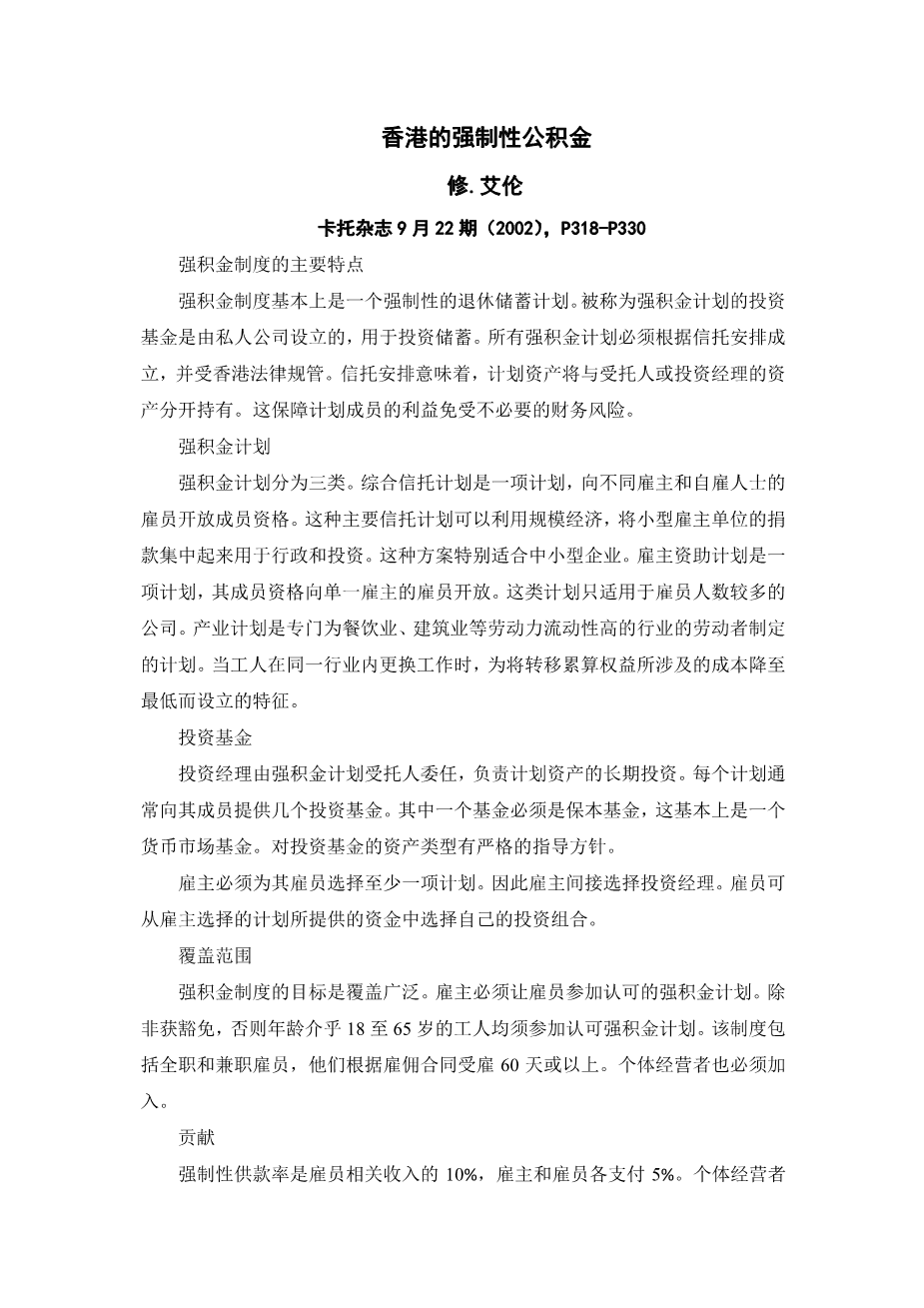Hong Kong#39;s mandatory provident fund
Siu Alan
Key Features of the MPF System
The MPF system is basically a forced retirement saving program. Investment funds, called MPF schemes, are set up by private companies to invest the savings. All MPF schemes must be established under trust arrangement and governed by Hong Kong law. The trust arrangement means that scheme assets will be held separately from the assets of the trustees or the investment managers. This safeguards the interest of the scheme members from unnecessary financial risks.
MPF Schemes
There are three types of MPF schemes. A master trust scheme is a scheme with open membership to workers of different employers and different self-employed persons. Such master trust schemes can exploit the economies of scale from pooling the contributions of small employer units together for administration and investment. This type of scheme is especially suitable for small- and medium-sized enterprises. An employer sponsored scheme is a scheme with membership open to the employees of a single employer. This type of scheme is only practical for companies with a large number of employees. An industry scheme is a scheme specially established for workers in industries with high labor mobility, such as the catering and construction industries. Features are set up to minimize the costs involved in transferring accrued benefits when workers change employment within the same industry.
Investment Funds
Investment managers are appointed by the trustees of MPF schemes to make long-term investment of scheme assets. Each scheme typically offers a couple of investment funds to its members. One of the funds must be a Capital Preservation Fund, which is basically a money market fund. There are strict guidelines on the types of assets in the investment funds.
Employers are mandated to choose at least one scheme for their employees.6 Employers therefore indirectly choose the investment managers. Employees can choose their own investment portfolio out of the funds provided by the scheme chosen by their employers.
Coverage
The MPF system is meant to have broad coverage. Employers are mandated to enroll their workers in approved MPF schemes. Unless exempted, workers aged between 18 and 65 are required to join the system by enrolling in approved MPF schemes. The system includes full-time and part-time employees who have been employed for 60 days or more under an employment contract. Self-employed workers are also required to join.
Contributions
The mandatory contribution rate is 10 percent of an employeersquo;s relevant income, with the employer and employee each paying 5 percent. Self-employed persons have to contribute 5 percent of their relevant income. Mandatory contribution is subject to a floor and a ceiling. Workers earning less than $4,000 a month do not have to contribute, but their employers have to contribute their 5 percent. Monthly income in excess of $20,000 is exempted. Mandatory contributions are tax deductible. Both the employer and the employee can opt to make extra, voluntary contributions in addition to the mandatory contributions. Due to the current economic downturn, starting from February 2003, workers earning less than $5,000 a month do not have to contribute to their MPF accounts, but their employers still have to contribute.
Vesting and Portability
Mandatory contributions made on behalf of a member of an MPF scheme and the investment returns will be fully and immediately vested in the scheme member. When an employee changes jobs, he can transfer his accrued benefits from his old scheme to the scheme chosen by his employer. Accrued benefits are therefore portable under the MPF system.
Preservation of Benefits
An employee cannot withdraw his accrued benefits before the retirement age, which is prescribed as 65. At retirement he can withdraw his benefits in a lump sum. Early withdrawal will be permitted when the worker attains the age of 60 and retires early, permanently departs from Hong Kong (only once in a lifetime), becomes totally incapacitated, or dies.
Mandatory Provident Fund Authority
The Mandatory Provident Fund Authority (MPFA) was set up in 1998 to regulate the operation of the MPF system. It received a $5 billion grant from the government and is meant to be self-financing. Its main functions are to approve trustees subject to stringent criteria prescribed in the Ordinance, to register MPF schemes that comply with the prescribed standards, and to ensure that the trustees comply with the legislative requirements.
Trustees are required to submit returns, financial statements, and auditorrsquo;s reports to the MPFA on a regular basis. The Authority will monitor the compliance of enrollment and payment of contributions by employers and self-employed persons. The Authority may also conduct field inspections, special audits, and investigations, and impose sanctions on a trustee in breach of the legislation.
Safeguards
The MPF system does not provide a guarantee on the minimum rate of return of the investment of the scheme assets. But there are safeguards against losses resulting from malfeasance or illegal conduct by the trustee and its service providers. Trustees are required to have insurance cover. A Compensation Fund was also set up, with $300 million injected by the government.11 If the losses to a registered scheme resulting from malfeasance or illegal conduct cannot be totally compensated by the resources of the trustee and other service providers or their insurance, the MPFA may apply to the court to use the Compensation Fund for compensation purpose.
MPF Retirement Benefits
The goal of the MPF system is to accumulate a fund to support a target income for members during retirement. The target is commonly expressed as a replacement rate that gives the ratio of real benefits to real earnings at the tim
全文共20903字,剩余内容已隐藏,支付完成后下载完整资料
英语译文共 9 页,剩余内容已隐藏,支付完成后下载完整资料
资料编号:[453290],资料为PDF文档或Word文档,PDF文档可免费转换为Word
以上是毕业论文外文翻译,课题毕业论文、任务书、文献综述、开题报告、程序设计、图纸设计等资料可联系客服协助查找。



